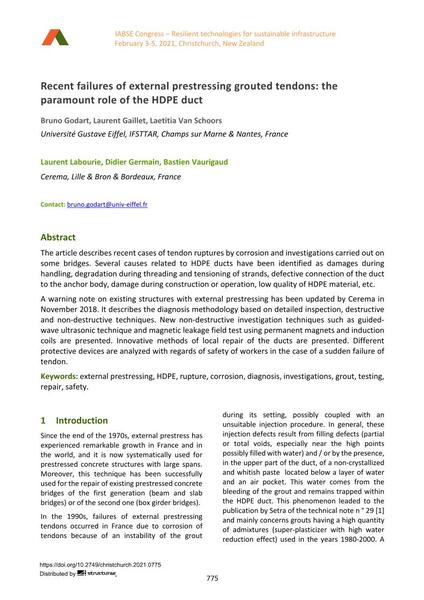Recent failures of external prestressing grouted tendons: the paramount role of the HDPE duct

|
|
|||||||||||
Détails bibliographiques
| Auteur(s): |
Bruno Godart
(Université Gustave Eiffel, IFSTTAR, Champs sur Marne & Nantes, France)
Laurent Gaillet (Université Gustave Eiffel, IFSTTAR, Champs sur Marne & Nantes, France) Laetitia Van Schoors (Université Gustave Eiffel, IFSTTAR, Champs sur Marne & Nantes, France) Laurent Labourie (Cerema, Lille & Bron & Bordeaux, France) Didier Germain (Cerema, Lille & Bron & Bordeaux, France) Bastien Vaurigaud (Cerema, Lille & Bron & Bordeaux, France) |
||||
|---|---|---|---|---|---|
| Médium: | papier de conférence | ||||
| Langue(s): | anglais | ||||
| Conférence: | IABSE Congress: Resilient technologies for sustainable infrastructure, Christchurch, New Zealand, 3-5 February 2021 | ||||
| Publié dans: | IABSE Congress Christchurch 2020 | ||||
|
|||||
| Page(s): | 775-782 | ||||
| Nombre total de pages (du PDF): | 8 | ||||
| DOI: | 10.2749/christchurch.2021.0775 | ||||
| Abstrait: |
The article describes recent cases of tendon ruptures by corrosion and investigations carried out on some bridges. Several causes related to HDPE ducts have been identified as damages during handling, degradation during threading and tensioning of strands, defective connection of the duct to the anchor body, damage during construction or operation, low quality of HDPE material, etc. A warning note on existing structures with external prestressing has been updated by Cerema in November 2018. It describes the diagnosis methodology based on detailed inspection, destructive and non-destructive techniques. New non-destructive investigation techniques such as guided- wave ultrasonic technique and magnetic leakage field test using permanent magnets and induction coils are presented. Innovative methods of local repair of the ducts are presented. Different protective devices are analyzed with regards of safety of workers in the case of a sudden failure of tendon. |
||||
